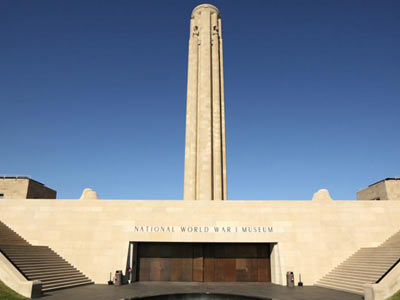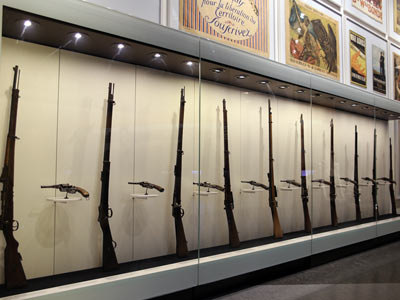The National World War I Museum and Memorial, originally called the Liberty Memorial Museum, opened in 1926. Its expansion was completed in 2006 and Congress designated it America’s official World War I Museum. Along with the Edward Jones Research Center, it is home to one of the largest Great War collections in the world, and has more than 75,000 items. It is encyclopedic in nature and includes small arms, artillery, artifacts and documents from most of the nations involved in the world’s first global conflict. Items include everything from rare treasures of national significance to a display of all of the items a soldier carried, putting his rifle and ammunition in a larger context. Small arms are not exhibited in a dedicated gallery. Instead the curators have put firearms into context with other artifacts and globally relevant concepts. The small arms collection includes all the classic WWI military production firearms. One case displays ten different bolt action rifles and pistols from the major combatants of WWI, and includes a fine skeletonized German M1879 Reichsrevolver. Another unique contextual display shows fourteen different kinds of ammunition alongside a Browning Automatic Rifle (BAR), America’s first fully automatic assault rifle. A French CSRG Chauchat 1915 machine rifle and accessories is displayed, as well as a rare 13mm Mauser T-Gewehr, the world’s first anti-tank rifle. The museum is curated into four general sections and the cases, lighting and displays are well designed, giving artifacts as many viewing vantage points as possible. Items are numbered, and referenced to labels at the base of the cases. 2004-era computer displays explain some firearms. The Online Collections Database includes period photographs and drawings of small arms but none of the machineguns, rifles or pistols in the collection are depicted and there is no online firearm catalog available, which compromises remote study. https://www.theworldwar.org/


 1. West Point Museum
1. West Point Museum 2. Springfield Armory
2. Springfield Armory 3. Smithsonian Museum
3. Smithsonian Museum 4. Nunnemacher Milwaukee
4. Nunnemacher Milwaukee 5. Wadsworth Atheneum
5. Wadsworth Atheneum 6. Rock Island Arsenal
6. Rock Island Arsenal 7. Metropolitan Museum NY
7. Metropolitan Museum NY 8. National World War I
8. National World War I 9. FBI Reference Collection
9. FBI Reference Collection 10. NRA National Firearms
10. NRA National Firearms 11. Connecticut History
11. Connecticut History 12. Remington Firearms
12. Remington Firearms 13. Davis Arms Museum
13. Davis Arms Museum 14. National Cowboy Mus.
14. National Cowboy Mus. 15. American Precision
15. American Precision 16. Collectors Firearms
16. Collectors Firearms 17. KY Military History
17. KY Military History 18. Cody Firearms Museum
18. Cody Firearms Museum 19. Woolaroc Museum
19. Woolaroc Museum 20. Kienbusch Philadelphia
20. Kienbusch Philadelphia 21. John Browning Museum
21. John Browning Museum 22. Art Institute Chicago
22. Art Institute Chicago 23. Henry Stewart VMI
23. Henry Stewart VMI 24. Autry Museum
24. Autry Museum 25. Wood Museum S&W
25. Wood Museum S&W 26. National WWII Museum
26. National WWII Museum 27. Frazier History Museum
27. Frazier History Museum 28. Pennsylvania Longrifle
28. Pennsylvania Longrifle 29. Frank Brownell Museum
29. Frank Brownell Museum 30. Inst. Mil. Technology
30. Inst. Mil. Technology 31. NRA Bass Pro Sporting
31. NRA Bass Pro Sporting 32. U S Army Museum
32. U S Army Museum